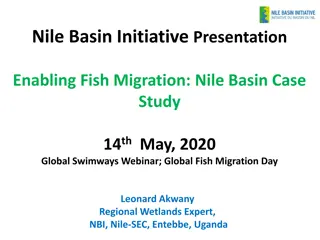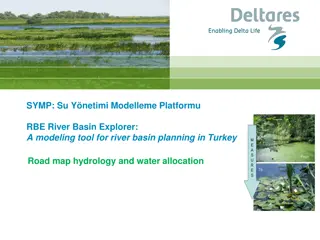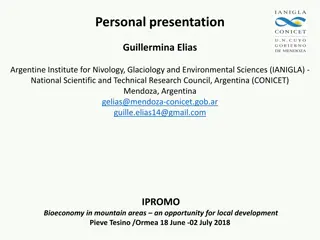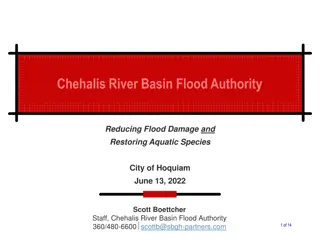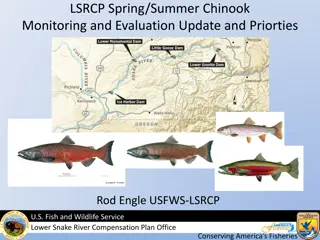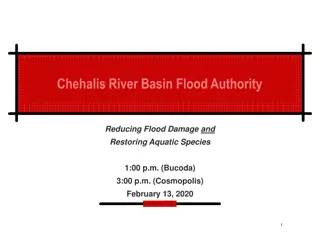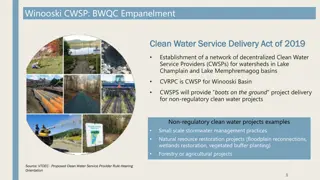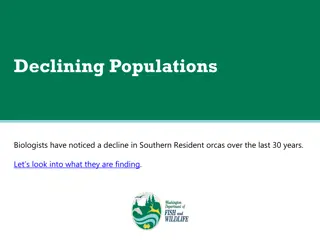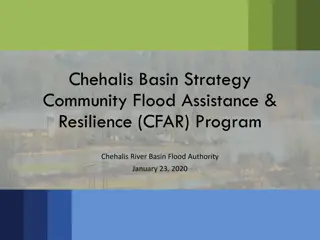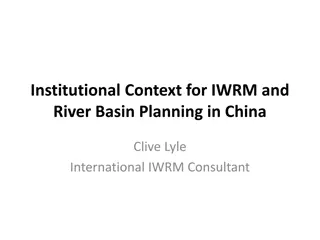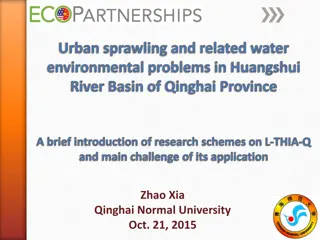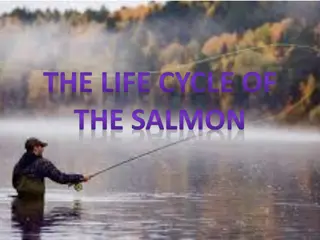Challenges Facing Chinook Salmon in the White River Basin
Chinook Salmon, also known as King Salmon, in the White River face various threats like barriers to migration, water quality issues, climate change impacts, and conflicts over water usage. These challenges include habitat degradation, increased flood frequency, retreating glaciers affecting salmon nests, altered stream flow patterns, and competition from non-native fish species. The complex interactions of these factors endanger the survival of Chinook Salmon populations in the region.
Download Presentation

Please find below an Image/Link to download the presentation.
The content on the website is provided AS IS for your information and personal use only. It may not be sold, licensed, or shared on other websites without obtaining consent from the author. Download presentation by click this link. If you encounter any issues during the download, it is possible that the publisher has removed the file from their server.
E N D
Presentation Transcript
Chinook Salmon Chinook Salmon, also called King Salmon, inhabit the White River. Construction of the flood-protection structure Mud Mountain Dam formed a barrier to natural migration of salmon species upriver, however, the U.S. Army Corps of Engineers transports them around the dam. The present condition of the White River Salmon populations within park boundaries is unknown at this time. In 2006, water temperatures and sediment levels exceeded state water quality standards in the upper White River drainages near and within the park.
Increased frequency and severity of floods and other high precipitation events stress juvenile fish and destroy incubating eggs by washing them downstream. Higher winter stream temperatures accelerate development of embryos and cause premature birth of fry before their food source (insects) hatch. Increasing water temperatures affect the availability of dissolved oxygen for respiration and decrease salmon health. Furthermore, non-native fish species such as small- mouth bass are better adapted to warmer temperatures and may out-compete cold water adapted salmon species for resources.
Retreating glaciers expose sediments that wash downstream during peak flow, burying salmon nests (called redds). The combination of warmer temperatures, less water, bark beetle infestation and longer frost-free seasons results in a longer and more robust wildfire season. Fire impacted areas are more prone to erosion, also leading to an increase of sediment in the rivers. Increases in fine sediments decrease the transport of dissolved oxygen through gravels and the suffocation of incubating eggs and irritate the gills of adult fish.
In the Pacific Northwest, streams are experiencing drastic changes in flow patterns, such as higher stream flow in March, reduced stream flow in summer, increased winter runoff, and earlier snowmelt-derived peaks in stream flow. Decreasing stream flow in the summer restricts spawning salmon from swimming upstream or traps juvenile fish in shallow pools. Maximum stream flow may not correspond to the developmental timing of juvenile downstream migration to salt water and/or upstream migration for spawning. For example, Chum, Coho, Pink and Chinook species are all known to migrate upstream in the late summer to early fall a period with low stream flow.
Hotter and dryer summer months require more Hotter and dryer summer months require more irrigation of farmland, sometimes requiring extraction irrigation of farmland, sometimes requiring extraction of water from streams with already depleted stream of water from streams with already depleted stream flow. This causes a conflict between environmental flow. This causes a conflict between environmental needs of maintaining and protecting spawning salmon needs of maintaining and protecting spawning salmon populations and the economic needs of farmers and populations and the economic needs of farmers and consumers. consumers.
Lower stream flow is also less able to dilute Lower stream flow is also less able to dilute urban runoff, leading to a greater urban runoff, leading to a greater percentage of contaminants in streams and percentage of contaminants in streams and lakes. Some contaminants, such as lakes. Some contaminants, such as endocrine disrupters found in many endocrine disrupters found in many household chemicals, can lead to genetic household chemicals, can lead to genetic mutations in fish and amphibians. In addition, mutations in fish and amphibians. In addition, other chemical pollutants such as pesticides other chemical pollutants such as pesticides can become stored in the muscle tissue of can become stored in the muscle tissue of fish and transfer to humans and other fish and transfer to humans and other animals when the fish are consumed. animals when the fish are consumed.
Reduced salmon populations effect food resources for Reduced salmon populations effect food resources for other animals such as black bears and predatory birds other animals such as black bears and predatory birds who feed on spawning salmon. Furthermore, salmon who feed on spawning salmon. Furthermore, salmon once served as an important food source of many once served as an important food source of many Native American people groups and continues to Native American people groups and continues to provide a centerpiece of tribal traditions and culture. provide a centerpiece of tribal traditions and culture. Reductions in wild salmon populations impact the Reductions in wild salmon populations impact the number of salmon available for harvest and cause number of salmon available for harvest and cause conflict between Native Americans and recreational conflict between Native Americans and recreational and career fishermen. and career fishermen.




![[✔PDF✔⚡] ✔DOWNLOAD✔ Ancestral Knowledge Of Smoking Salmon: The Ultimate Gui](/thumb/68084/pdf-download-ancestral-knowledge-of-smoking-salmon-the-ultimate-gui.jpg)



